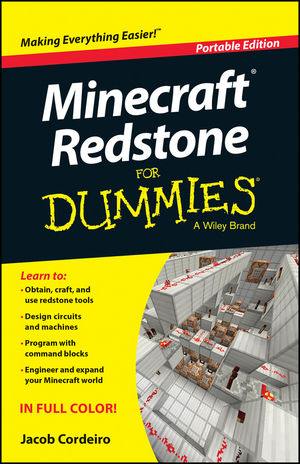
I have recently reviewed a couple of books in Wiley’s Dummmies series, one for beginning players and one that will be useful to most Minecrafters. Continuing in that pattern, here’s a book that covers more advanced topics. Minecraft Redstone for Dummies, Portable Edition, written by Jacob Cordeiro, tackles the most complex (and hardest to explain!) aspects of the game.
Redstone engineering is Minecraft’s equivalent of electronic circuits, and has been used by inventive Minecrafters to do the most extraordinary things. As if that wasn’t enough, this book aims to not only teach you how to do stuff with Redstone, it goes on to tackle Command Blocks and Data Tags, two subjects that are even more technical.
The Redstone section of the book is arranged like a school course: first you learn the basic idea of Redstone—how blocks are powered and how currents flow—and then how to do some simple tasks like opening doors and powering minecart rails.
Then the material becomes more involved, with more detailed information on the rules covering what Jacon calls Power Production and Power Reception (i.e. what I call ‘Power Sources’ and ‘Devices’ on this site), before going on to the basic elements of complex Redstone engineering, the logic gates, clocks and latches. Although everything is described differently from the way I do it here, it’s all correct and just goes to show there is more than one way to think about any topic. If my Redstone pages are confusing, this book might make more sense to you, and vice versa.
There’s enough information here to make this book a good by for Minecraft players who want to learn how to do this stuff, but I’m not even half way through!
Minecraft provides additional ways to do really complicated stuff, that are not available through normal game play but can be accessed by typing commands into the console. The second half of this book will walk you through these console commands, as well as using the Command Block to customise your game experience, and the Data Tags you can use to customise objects in the game. This is complex material and steps over the line into computer programming.
If this book has a weakness, it is that it is a little bit short of examples of why you would want to do this stuff. There are a couple of chapters with project ideas at the end of the book, but they are brief and look like an afterthought; it would be good to have included some examples of really ambitious Redstone projects or custom game worlds. On the other hand, it’s not exactly hard to find examples of awesome things people have done in Minecraft if you look on YouTube, Reddit or other places where Minecrafters exchange ideas. Whilst all the pictures are once again reproduced well in full colour, I do think that some of the screen shots are a bit hard to understand: I do of course know how hard this can be to do, but I think at times more thought could have gone into composition and choice of textures. Isometric rendering would have been worth considering, too!
These are minor complaints, however. In summary I would say that for people wanting to learn Redstone, the first half of this book makes a good alternative to the equivalent sections on minecraft101.net. And since I don’t (currently) cover that material, I can unreservedly recommend Minecraft Redstone For Dummies as an introduction and reference for Commands and Data Tags.
Minecraft Redstone For Dummies, Portable Edition
by Jacob Cordeiro
Wiley, 160pp
